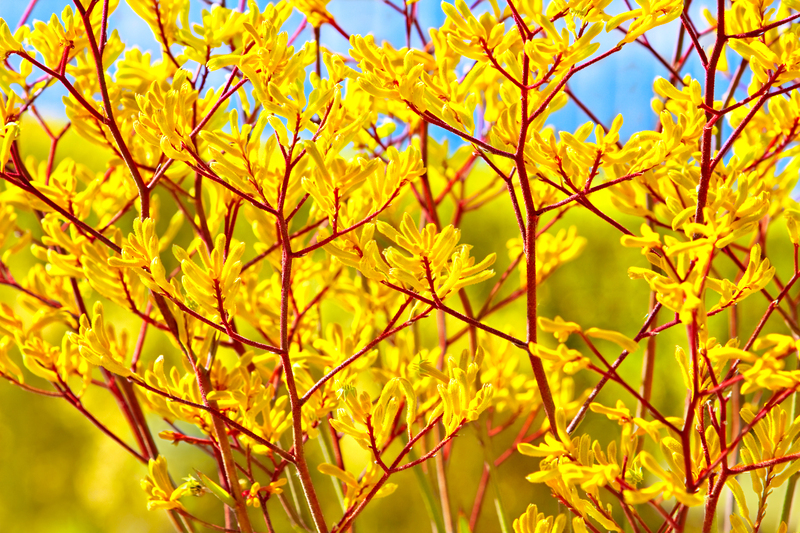Maximize greenery with vertical gardening
Posted on 02/10/2025
Maximize Greenery with Vertical Gardening: Transform Your Space Into a Lush Paradise
In today's urban-centric world, lush green spaces often seem like a luxury. Limited space, high-rise apartments, and small backyards challenge gardening enthusiasts. However, there's good news for plant lovers: vertical gardening is revolutionizing the way we think about greenery, enabling you to fully maximize greenery with vertical gardening techniques. Whether you're looking to beautify a balcony, add life to a blank wall, or grow your herbs and vegetables, vertical gardens offer an innovative and rewarding solution. Read on for a comprehensive guide on how to make the most of your space by going vertical.

What is Vertical Gardening?
Vertical gardening is the art and science of growing plants upward--on trellises, walls, towers, or frames--rather than outward. These systems harness unused vertical surfaces, turning bland walls or fences into vibrant, oxygen-producing habitats. By maximizing greenery with vertical gardening, you enhance air quality, control indoor temperatures, and add stunning aesthetics to any area.
Why Embrace Vertical Gardening?
There are numerous compelling reasons to embrace vertical gardening techniques:
- Space Efficiency: Perfect for urban environments or small yards, vertical gardens utilize otherwise wasted vertical real estate.
- Enhanced Air Quality: Plants filter pollutants, dust, and harmful chemicals, leading to cleaner air indoors and outdoors.
- Thermal Insulation: Living walls can help moderate building temperatures, reducing energy consumption.
- Aesthetic Appeal: Instantly transform dull walls into lush, dynamic displays.
- Year-Round Greenery: Many vertical gardening systems accommodate seasonal and perennial planting options.
- Accessibility: Say goodbye to back-breaking garden chores--vertical gardens can be tailored to ergonomic heights.
Types of Vertical Gardens
To fully maximize greenery with vertical gardening, it's essential to select the right kind of system for your needs. Below are some of the most popular types of vertical gardens:
1. Living Walls (Green Walls)
Living walls are large panels fitted with lush plants, often supported with hydroponic systems. They're ideal for substantial spaces, inside or out, and provide a breathtaking visual impact.
2. Pocket Planters
Hanging fabric pocket systems allow you to grow an array of plants, from herbs to flowers. These are a fantastic starting point for beginners and fit well on fences or apartment balconies.
3. Trellises & Climbing Structures
Traditional trellises support vining plants like tomatoes, peas, and flowering climbers. They're simple, affordable, and bring both green and floral beauty to small gardens.
4. Vertical Pallet Gardens
Repurposed wooden pallets can be ingeniously transformed into upright, multi-level planters. They are eco-friendly and suitable for both edible and ornamental plants.
5. Tower Gardens
Tower planters stack horizontally, saving precious floor space. They often use hydroponic or soil-based systems to grow everything from vegetables to succulents.
6. Modular Planters
These offer customizable, stackable units to fit any design vision--great for both residential and office environments.
How to Plan and Build a Vertical Garden
Step 1: Assess Your Space
- Light Quality: Determine how much sunlight your vertical garden will receive. Full sun, partial shade, or full shade will dictate your plant choices.
- Wall Strength: Ensure that any structure or wall you use can support the weight of your chosen system, soil, and mature plants.
- Water Access: Consider proximity to water sources, as vertical gardens often require irrigation systems for optimal growth.
Step 2: Select a Vertical Gardening System
- Choose a pre-made system (such as a modular or hydroponic wall), or craft your DIY version with reclaimed wood, pockets, or shelving.
- Ensure the system matches your skill level and maintenance preferences.
Step 3: Pick the Right Plants
When you maximize greenery with vertical gardening, your plant choices are vital. Opt for varieties that thrive in your environment and don't outgrow the system.
- Edible Plants: Herbs (mint, thyme, parsley), greens (lettuce, spinach), strawberries, and dwarf tomatoes.
- Ornamental Plants: Ferns, succulents, ivies, begonias, trailing petunias.
- Climbers: Jasmine, clematis, bougainvillea, morning glories.
- Native species tend to be low-maintenance and beneficial for local ecosystems.
Step 4: Install and Plant
- Secure your system to the wall or frame, confirming stability and drainage.
- Plant the largest specimens at the base, working upward with lighter, trailing species.
- Set up an irrigation system, if possible--automatic drippers are perfect for living walls and large installations.
Step 5: Maintenance and Monitoring
- Regularly check soil moisture and water as needed; vertical gardens typically dry out faster than traditional beds.
- Feed with a balanced fertilizer suited to your plant selection.
- Prune and remove dead or diseased growth swiftly to maintain plant health and visual appeal.
Vertical Gardening Design Tips
Design is key to successfully maximizing greenery with vertical gardening solutions. Here's how to elevate your space artistically and functionally:
- Layering: Combine textures and colors by mixing upright, trailing, and climbing plants.
- Focal Points: Place statement plants (like ferns or monstera) at eye level.
- Symmetry vs. Freeform: Choose between grid arrangements for a modern look or eclectic patterns for a whimsical flair.
- Seasonal Planning: Incorporate evergreens with annual bloomers for all-season interest.
- Upcycling Materials: Use old shoe organizers, pallets, or rain gutters for budget-friendly and sustainable installations.
- Lighting: For interior walls, supplement with LED grow lights to ensure robust growth.
Best Plants for Vertical Gardens
Wondering which species will thrive as you maximize your greenery in a vertical setup? Here are some top picks:
- For Sun: Nasturtiums, strawberries, cherry tomatoes, basil, bougainvillea.
- For Shade: Ferns, trailing ivy, philodendron, pothos, fuchsia.
- For Indoors: Spider plant, peace lily, golden pothos, snake plant, succulents.
- Showstoppers: Bromeliads, orchids, air plants, anthuriums.
Tips for Plant Selection:
- Choose compact varieties that don't outgrow your system.
- Mix annuals and perennials for dynamic displays.
- Group plants with similar light and water requirements together.
Vertical Garden Care: Ensuring Lush Growth Year-Round
Once your vertical garden is in place, a few sustainability practices will allow you to maximize greenery all year long:
- Water Wisely: Water from the top and let gravity aid even distribution. Install drip irrigation or self-watering reservoirs for consistency.
- Fertilize Regularly: Apply a balanced fertilizer monthly for robust plant health.
- Monitor Pests: Vertical gardens may be less prone to ground pests, but regularly inspect for aphids, spider mites, and fungus.
- Trim and Prune: Keep foliage dense and manageable by cutting back excessive growth.
- Refresh Soil: Once or twice a year, change or replenish soil as it can become compacted and depleted.
Creative Ideas to Maximize Greenery with Vertical Gardening
- Edible Living Walls: Grow salad greens, herbs, and cherry tomatoes for a beautiful and functional kitchen display.
- Flowering Walls: Combine petunias, nasturtiums, and lobelias for bold seasonal color.
- Privacy Screens: Use dense climbing vines or bamboo in modular systems to create natural, verdant privacy between yards or balconies.
- Indoor Moss Walls: Incorporate preserved or live moss for low-maintenance, calming green interiors.
- Succulent Art: Craft geometric patterns with colorful succulents in shallow-framed living paintings.
- Children's Sensory Walls: Grow safe-to-touch and aromatic plants like lamb's ear, mint, and lavender at child-friendly heights.
Sustainable Benefits of Vertical Gardening
Beyond maximizing your lush decor, vertical garden systems support urban biodiversity, contribute to energy efficiency, and reduce your ecological footprint. Here's how:
- Urban Cooling: Living walls naturally insulate, reducing the urban heat island effect and lowering air-conditioning costs.
- Rainwater Capture: Many vertical gardens can include rainwater catchment, decreasing runoff and saving water.
- Biodiversity: Pollinator-attracting plants on green walls support bees, birds, and beneficial insects in city centers.
- Air Purification: Vertical installations capture particulate matter and transform carbon dioxide into fresh oxygen.

Common Challenges and How to Overcome Them
While the idea of maximizing greenery with vertical gardening is appealing, it's important to be aware of potential challenges:
- Watering Demands: Vertical gardens dry out faster than ground gardens. Solution: automatic irrigation or frequent manual watering ensures consistent moisture.
- Structural Issues: Heavy systems may damage walls. Solution: use lightweight, modular planters and regularly check mounting hardware.
- Pest & Disease Management: Regular inspection and organic pest control can keep infestations at bay.
- Plant Growth Regulation: Prune regularly and select plants that don't overgrow their space.
Conclusion: Enrich Your Life and Environment
Adopting vertical gardening is more than a design trend--it's a transformative way to bring lush, sustainable greenery into any environment, regardless of space constraints. By thoughtfully planning, selecting suitable systems and plants, and maintaining with care, you can maximize greenery with vertical gardening and create an oasis that nourishes both your soul and the planet.
Ready to go vertical? Start with a small pocket planter or transform an empty wall into a living canvas. No matter your skill level, there's a vertical gardening solution waiting for you. Maximize your greenery and inspire others to reimagine what's possible--one wall, one tower, one gorgeous green space at a time.

